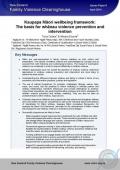 Issues Paper 6, April 2014
Issues Paper 6, April 2014
Authors: Terry Dobbs1 & Moana Eruera2
1 Ngāpuhi iwi, Te Mahurihuri Ngāti Pakau hapū, MA (Childhood and Youth Studies) (Dist), PostGrad Dip Child Advocacy (Dist), Certificate of Qualification in Social Work (CQSW)
2 Ngāpuhi / Ngāti Ruanui oku iwi, M.Phil (Social Work), PostGrad Dip Social Policy & Social Work, BA, Registered Social Worker
Downloads
Key messages
- Māori are over-represented in family violence statistics as both victims and perpetrators. The causes of whānau violence are acknowledged as complex and as sourced from both historical and contemporary factors. The impact of colonisation needs to be considered in order to respond effectively to whānau violence.
- Western approaches have not curbed the epidemic of whānau violence. Multi-level approaches to whānau violence prevention and intervention are more likely to achieve the best results.
- Understanding the difference between whānau and family is critical in terms of any prevention and intervention practices, policies and legislation.
- The use of cultural imperatives, for example, whakapapa, tikanga, wairua, tapu, mauri, and mana, has the potential to inform wellbeing in intimate partner and whānau relationships, transform behaviours and provide alternatives to violence. Using these imperatives can guide transformative practices and inform strategies for whānau violence prevention and whānau wellbeing. They can also be seen as protective factors within whānau, hapū and iwi.
- Culturally responsive initiatives and programmes that restore and strengthen whānau and communities should be considered as well as the individual based interventions of mainstream for Māori whānau. Kaupapa Māori conceptual frameworks, for example the Mauri Ora framework, advocate for the development of Māori models that change the way whānau violence is understood and managed.
- Successful programmes are likely to have:
- Māori population based responses that complement the work of Māori and other community-based intervention services. These should be grounded in te reo me ona tikanga (Māori language and culture), underpinned by Māori values and beliefs, Māori cultural paradigms and frameworks
- Government agencies working in close collaboration with iwi organisations to facilitate the implementation of Māori whānau violence prevention initiatives that meet the needs, priorities and aspirations of iwi
- Funding sufficient to (a) engage leaders and staff who have the nationally and locally recognised skills to ensure successful implementation of violence prevention initiatives, and (b) to allow for local consultation and subsequent responsiveness in planned activities and projects
- Support for capacity building opportunities for both prevention and intervention staff, including opportunities for networking, advocacy, and training
- Māori violence prevention initiatives that are funded for research and evaluation in a way that builds local knowledge within a Māori worldview.
Recommended citation
Dobbs, T. & Eruera, T. (2014). Kaupapa Māori wellbeing framework: The basis for whānau violence prevention and intervention. Auckland, New Zealand: New Zealand Family Violence Clearinghouse, University of Auckland.
ISSN: 2253-3222, published online only


